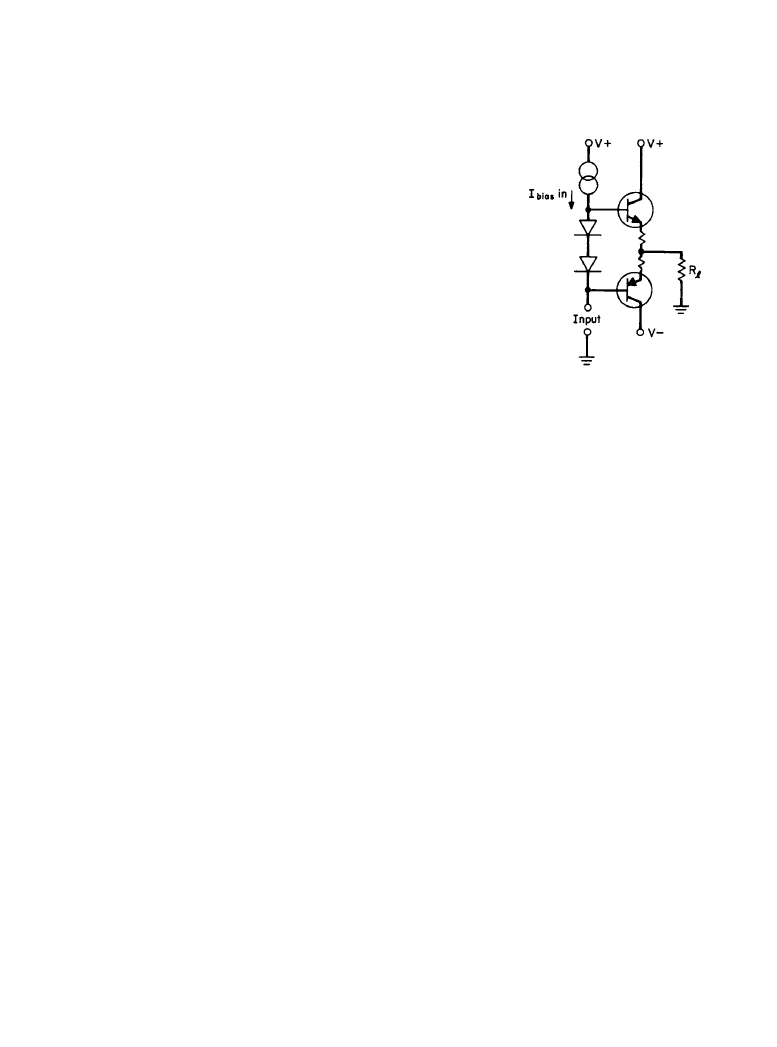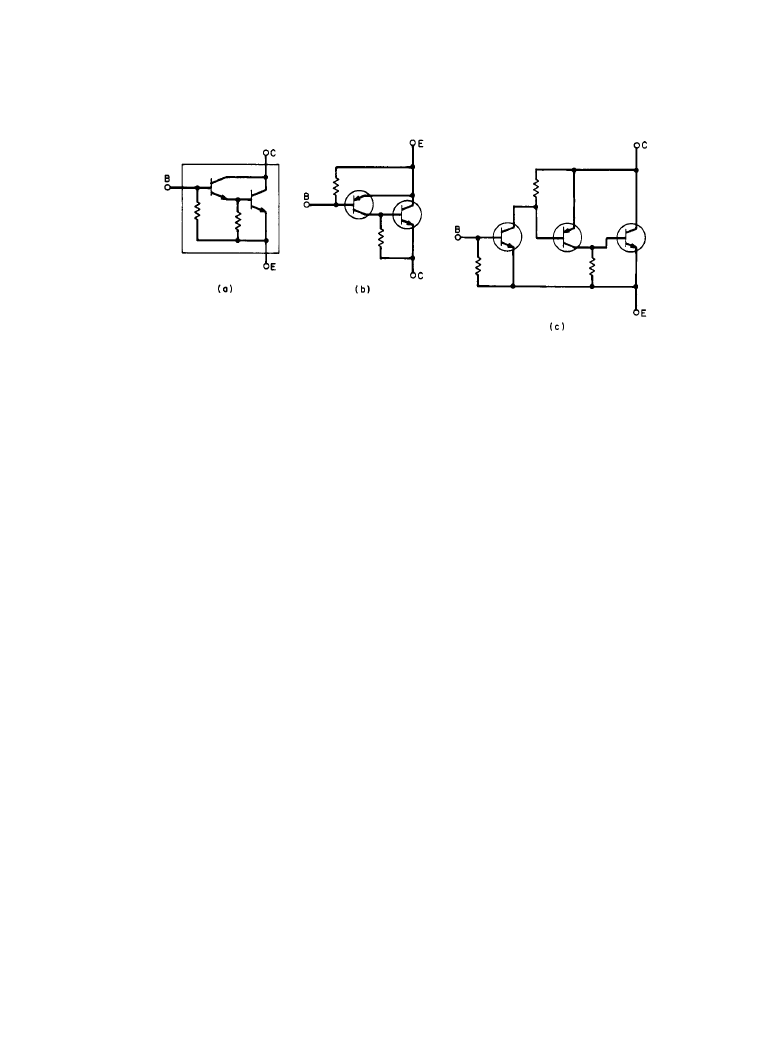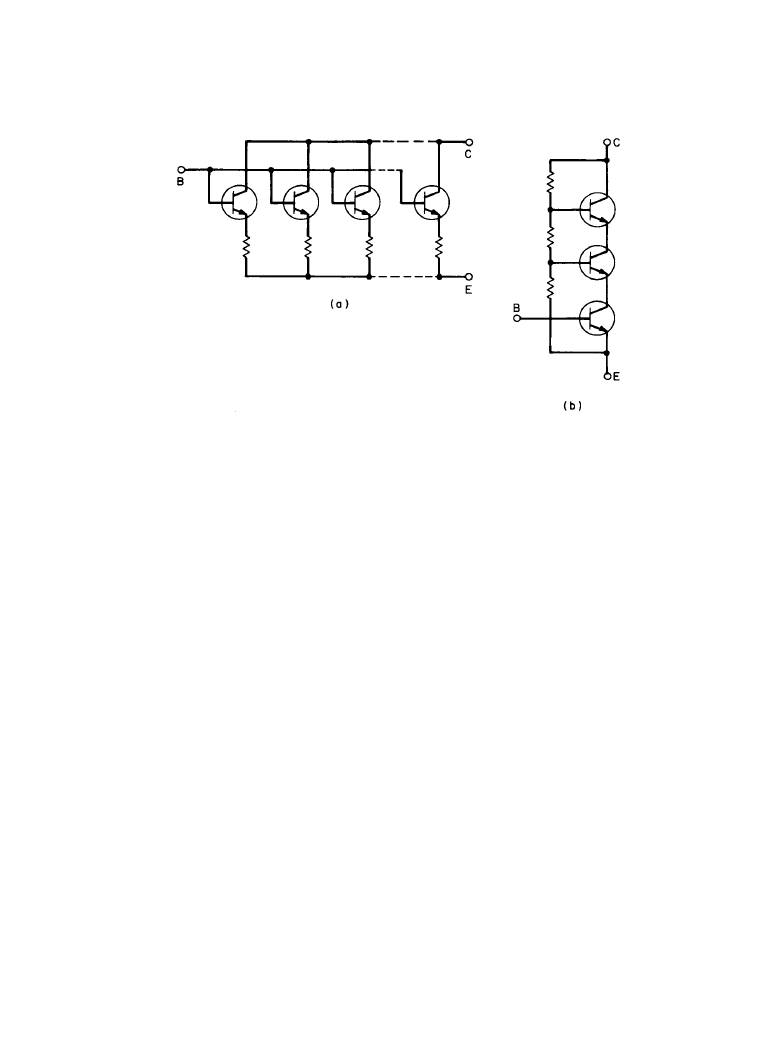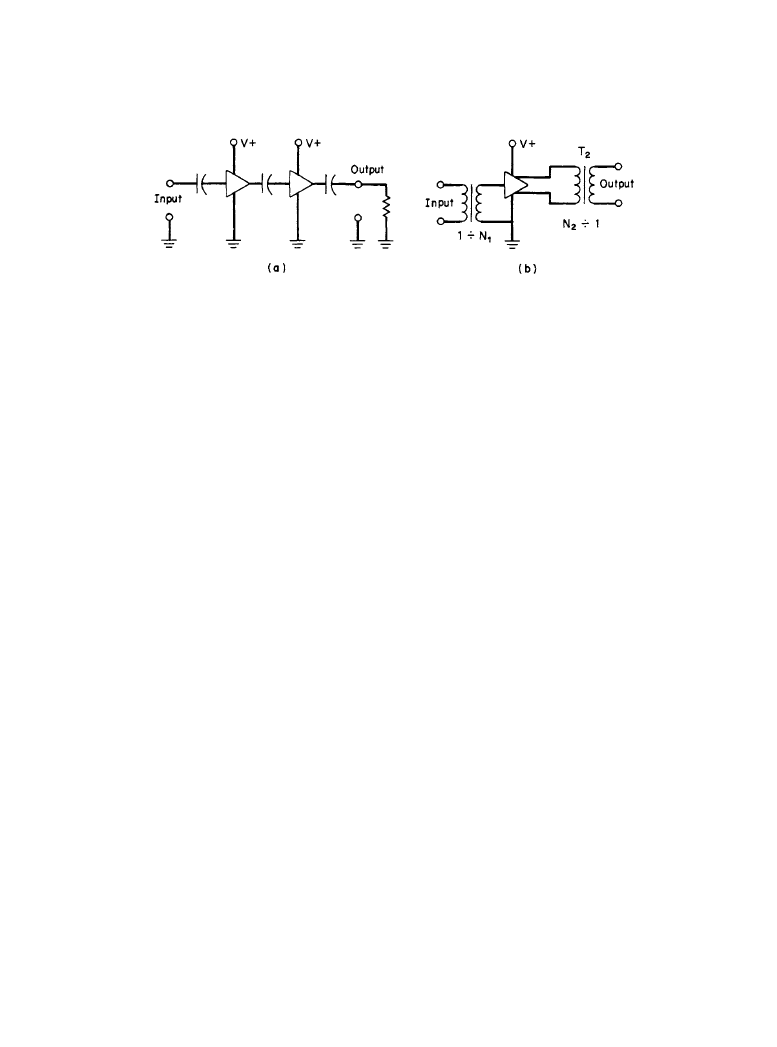ВУЗ: Казахская Национальная Академия Искусств им. Т. Жургенова
Категория: Книга
Дисциплина: Не указана
Добавлен: 03.02.2019
Просмотров: 21651
Скачиваний: 19

Low Power Amplifiers 4-55
Almost the same performance can be expected when the commonly connected emitters or
sources are supplied by a resistor instead of a current source or the two input circuits have differ-
ing impedances. The long-tailed pair performs best when the two devices are matched and oper-
ate at the same temperature. For this reason, matched monolithic transistors and FET provide the
best performance, with the additional benefit that, with equally shared current, even-harmonic
distortion is substantially reduced when compared with single-ended amplifiers.
Two-device amplifier stages are not restricted to a construction using two devices of the same
type (bipolar versus FET) or the same polarity (NPN versus PNP). Using stages of opposite
polarity often results in a higher available amplification factor and output voltage when limita-
tions of supply voltage are considered (Figure 4.3.6c).
A common use of transistors or FETs of differing polarity is in series-connected push-pull
amplifiers (Figure 4.3.7), where one stage supplies current of one polarity from one supply volt-
age to a grounded load and the other stage supplies opposite-polarity current from a supply volt-
age of opposite polarity. The bias current flows from one supply to the other through the two
devices without passing through the load. Here, the two stages may have a relatively low bias
current that is often stabilized by a diode per device connected in shunt with the base circuit and
kept at the same temperature as the amplifying transistors. As the transistors temperature
increases with heat, the base-emitter voltage decreases and the diode forward voltage decreases
also, thereby keeping the quiescent current in the transistors within much smaller limits than
without diode compensation.
Cascaded Transistors
Transistors connected in cascade with overall voltage feedback are basic building blocks of
amplifiers. When the collectors of two NPN transistors are connected together with the base sig-
nal of the second transistor derived entirely from the emitter of the first, an NPN Darlington tran-
sistor (Figure 4.3.8a) is described that has only three terminals: the emitter of the second, the
base of the first, and the common collector of both. Additional internal base-emitter resistors
ensure that leakage currents cannot cause conduction in the last transistor. Such a cascaded tran-
sistor may have a current gain nearly equal to the product of the two current gain factors, requires
an input voltage which is two base-emitter voltages higher than the emitter voltage, and can
Figure 4.3.7
Input signal and bias circuit in a single-ended push-
pull amplifier.
Downloaded from Digital Engineering Library @ McGraw-Hill (www.digitalengineeringlibrary.com)
Copyright © 2004 The McGraw-Hill Companies. All rights reserved.
Any use is subject to the Terms of Use as given at the website.
Low Power Amplifiers

4-56 Microphone Devices and Systems
reach in normal operation a minimum voltage drop between the external collector-emitter termi-
nals equal to one base-emitter voltage. Two PNP transistors can be similarly interconnected.
The collector of a first PNP transistor can be connected to supply the entire base current of a
second NPN transistor, with the emitter of the first transistor connected to the collector of the
second transistor (Figure 4.3.8b). The entire assembly now functions as a compound PNP tran-
sistor having as its base terminal the base of the first PNP transistor, as its collector the emitter of
the second NPN transistor, and as its emitter the emitter of the first PNP and the collector of the
second NPN transistor. The input voltage now must be one base-emitter voltage lower than the
emitter voltage because of the reversed current flow in PNP transistors, and the minimum volt-
age drop between the collector-emitter terminals is now one base-emitter voltage. The two com-
pound transistors described here are the compound output devices in quasi-complementary push-
pull amplifiers.
Three or more transistors of like or mixed polarity may be cascaded, such as PNP-NPN-NPN
or NPN-PNP-NPN (Figure 4.3.8c), to form compound PNP or NPN transistors, respectively.
Here, the polarity of the input transistor defines the polarity of the compound transistor. The
minimum voltage drop and the required input voltage may be different in each connection,
becoming highest when only devices of the same polarity are used.
Parallel-Connected Devices for High Currents
When high currents have to be delivered to a load, several transistors or FETS are often con-
nected in parallel, with each device sharing a portion of the output current (Figure 4.3.9a).
Nearly equal current sharing can be achieved when all devices are matched to each other as much
as possible. Current sharing can be improved when each of the devices has local current feed-
back with equal separate emitter or source resistors connected to the common emitter or source
connection and all devices share a common heat sink. The emitter resistor for bipolar transistors
is typically a fraction of 1
Ω, which allows current sharing to currents as low as a fraction of 1 A.
The circuit layout for a parallel connection must be done carefully to avoid constructing an
oscillator circuit at very high frequencies. When using power FETs, it is necessary to connect
Figure 4.3.8
Cascaded circuits: (
a) compound Darlington or coupled emitter follower, (b) com-
pound PNP-NPN transistors, (
c) triple compound NPN-PNP-NPN transistors.
Downloaded from Digital Engineering Library @ McGraw-Hill (www.digitalengineeringlibrary.com)
Copyright © 2004 The McGraw-Hill Companies. All rights reserved.
Any use is subject to the Terms of Use as given at the website.
Low Power Amplifiers

Low Power Amplifiers 4-57
series resistors of a few ohms in series with each gate lead and, perhaps, to have a ferrite bead in
each gate lead to avoid oscillation.
Series-Connected Devices for High Voltage
When high voltages have to be delivered to a load and single devices are incapable of operating
at the maximum peak voltage, several devices can be connected in series to share the voltage
while conducting nearly the same current. The resulting totem-pole connection for transistors
involves connecting the transistors so that the emitter of the second transistor is tied to the collec-
tor of the first and the emitter of the third transistor is tied to the collector of the second, and so
on (Figure 4.3.9b). A series string of as many equal resistors as there are transistors has its ends
connected to the collector of the last transistor and the emitter of the first transistor, and each
junction is connected in the same sequence to the base of the same transistor in the sequence,
except to the first transistor, whose base receives the input signal. The object of this circuit is to
have the first transistor operate as a grounded-emitter device, driving all the others as grounded-
base devices. This goal is not perfectly achieved, particularly at high frequencies and at high-out-
put currents where voltage division in the resistor string under load departs from uniformity.
AC-Coupled Multistage Amplifiers
Amplification of a given signal usually does not include amplification of the dc component of
the source of signals. One or more coupling capacitors between stages of amplification reduce
the low-frequency response of the system and prevent the dc offset voltages from being propa-
gated to the output (Figure 4.3.10a). When using transistor amplifiers in this fashion, the input
impedance of a single-ended input stage after each capacitor may act as a partial rectifier diode
for the pulsating signal and produce a low-frequency transient for each pulse. The solution to this
Figure 4.3.9
High-voltage and high-current circuits: (
a) current-sharing parallel transistors, (b)
totem-pole series-connected transistors.
Downloaded from Digital Engineering Library @ McGraw-Hill (www.digitalengineeringlibrary.com)
Copyright © 2004 The McGraw-Hill Companies. All rights reserved.
Any use is subject to the Terms of Use as given at the website.
Low Power Amplifiers

4-58 Microphone Devices and Systems
problem may be, in part, the use of FET circuits, the use of push-pull circuits, and the selection
of low-frequency time constants in the amplifier and power supply filtering circuits.
Amplifier stages may be coupled with transformers to the signal source and load and to each
other (Figure 4.3.10b). Transformers are excellent devices that can reject common-mode inter-
fering signals which may appear on a program line, and they can also match the source and load
impedances to the amplifier circuit. Such an impedance match is needed, for example, in ampli-
fiers operating from a power supply directly connected to the power line where connection of
external loudspeakers or headphones would present a shock hazard. Transformers are the only
practical components that can match the devices in broadband radio-frequency power amplifiers
to source and load.
4.3.2d
Power Output Stages
Power output stages of audio or video amplifiers usually are called upon to drive a variety of
loads, which may or may not be connected when the signal or the power supply is turned on.
Consequently, not only must power amplifiers be stable with any load, but they must be tolerant
of excessive signals or loads unless such conditions are prevented from occurring [6].
Single-Ended Amplifiers
A single-ended amplifier has only one single or compound transistor or FET acting as a variable
controlled resistor between power supply and load. The load may be coupled to the output stage
through a capacitor or a transformer, which must also return the average direct current to the
power supply. Single-ended amplifiers intended for audio-frequency amplification are usually of
low power output capability and generally operate from a single power supply voltage. In a sin-
gle-ended amplifier, transformer- or choke-coupled to the load, the bias current through the
device must be at least equal to the peak current through the load and the peak voltage across the
load must be less than the supply voltage when the turns ratio of the transformer is 1:1 between
the primary and secondary windings.
Push-Pull Amplifiers
A push-pull amplifier has at least one pair of single or compound output devices that act as vari-
able resistors between supply and load, with the first device pushing load current in one direction
Figure 4.3.10
AC amplifier circuits: (
a) cascaded, capacitor-coupled, (b) transformer-coupled.
Downloaded from Digital Engineering Library @ McGraw-Hill (www.digitalengineeringlibrary.com)
Copyright © 2004 The McGraw-Hill Companies. All rights reserved.
Any use is subject to the Terms of Use as given at the website.
Low Power Amplifiers

Low Power Amplifiers 4-59
while the other pulls load current in the opposite direction under control of the input signal.
When the two devices have the same characteristics and the driving signal is equally balanced,
the direct current and all even-harmonic distortion in the load current are canceled [7].
Parallel-DC, Series-AC Amplifiers
The usual transformer-coupled amplifier (Figure 4.3.11) has two like devices connected between
ground and the end of the primary winding of the transformer, with the supply voltage fed to the
center tap of the same winding. Signal voltage is fed to the two devices with opposed phase so
that one device increases conduction of current while the other decreases conduction.
The load may be connected to a secondary winding or between the ends of the primary wind-
ing. When it is connected in the latter way, maximum conduction of one device, resulting in
nearly 0 V at that point, will raise the voltage at the opposite device to almost twice the power
supply voltage, which then becomes the peak voltage across the load.
The peak-to-peak voltage across the load then becomes nearly 4 times the power supply volt-
age, and the peak load current becomes nearly 2 times the power supply voltage divided by the
load resistance. The average power supply current is equal to the sum of the average current
drawn by each device. Thus, the dc supply load is in parallel, while the ac load signal is in series
between the two devices.
The parallel-dc, series-ac push-pull amplifier provides a very high relative power output when
supply voltage is low, as in the 12-V automotive electrical system. The transformer- or choke-
coupled amplifier makes use of two like devices and is therefore the preferred connection in
radio-frequency power amplifiers.
Series-DC, Parallel-AC Amplifiers
With the availability of complementary transistors as amplifiers, the single-ended or half-bridge
amplifier became practical as a transformerless power amplifier in the early 1960s. Prior to that
time such amplifiers were constructed by using driver transformers or floating phase inverter
amplifiers.
A half-bridge amplifier that is fully balanced has one device connected between the load and
one power supply and a second complementary device connected between the load and a second
power supply of opposite polarity but the same voltage. The load and the two power supplies are
connected to a common ground. The driving voltage is fed to both devices without phase inver-
sion, decreasing conduction in one device while increasing conduction of an opposite current in
the other direction.
Figure 4.3.11
Series-ac, parallel-dc push-pull
amplifier.
Downloaded from Digital Engineering Library @ McGraw-Hill (www.digitalengineeringlibrary.com)
Copyright © 2004 The McGraw-Hill Companies. All rights reserved.
Any use is subject to the Terms of Use as given at the website.
Low Power Amplifiers